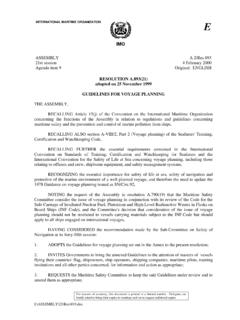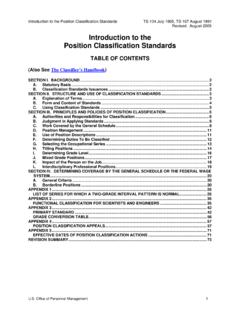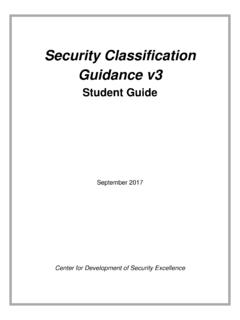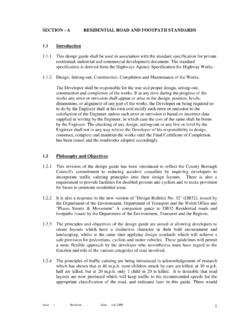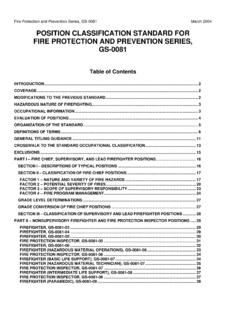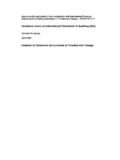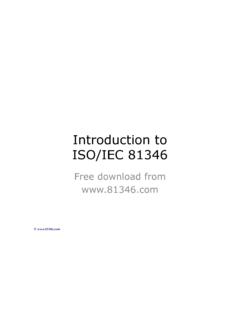Transcription of CHS Hydrographic Survey Standards
1 Canadian Hydrographic Service Standards FOR Hydrographic SURVEYS PREFACE These Standards are based on the fifth edition of IHO Special Publication No. 44 (S-44), (February 2008) and on the previous Standards versions of the Canadian Hydrographic Service (CHS). It shall be noted that the issue of a new standard does not invalidate charts and nautical publications based on previous Standards , but rather sets the Standards for future data collection to respond better to user needs. Regions are encouraged to develop estimates of the positional and depth accuracies of Hydrographic surveys conducted prior to the implementation of these new Standards . The principal aim of these Standards is to specify requirements for Hydrographic surveys in order that Hydrographic data collected according to these Standards is sufficiently accurate.
2 An additional aim of the standard is to ensure that the spatial uncertainty of data is adequately quantified. Previous versions of CHS Survey Standing Order (SSO) concentrated primarily on specifying accuracies for Hydrographic surveys for the compilation of nautical charts. These Standards do not include procedures that are included in other related documents. These Standards must be used in conjunction with the Hydrographic Survey Management Guidelines, the ISO quality system process documentation, and the data coding guides. These Standards will help Hydrographers and contractors to meet CHS Survey precision and quality requirements. Prepared by : Canadian Hydrographic Service Fisheries and Oceans Canada June 2013, Edition 2 List of major changes N.
3 Date Section Description 1 2010-03-25 A paragraph has been added to give more precision on the order to use when positioning navigational aids and other features. 2 2012-02-01 1 Revision of the Table 1. Change the order number and description to correspond with IHO S44, 5th edition. All references to these orders in the document have been replaced. 3 2012-02-01 In 4th paragraph, a clarification on the use of horizontal datum is added. 4 2012-02-01 Reference to the CHS GPS Survey Standing Orders document has been removed and replaced by a reference to national or provincial geodetic agencies. 5 2012-02-01 In 3rd paragraph, the exception on the accuracy of the position of the sounding has been removed.
4 6 2012-02-01 Revision of the Table 2. Change the order number to correspond with IHO S44, 5th edition. 7 2012-02-01 Remove references to astronomic reference datum. 8 2012-02-01 Remove references to astronomic reference datum. 9 2012-02-01 In the 1st paragraph, 3rd sentence, add the following clarification: with respect to the motion reference unit . 10 2012-02-01 The end of the last sentence has been changed from the sound speed data needs to be considered to the sound speed data must be considered . 11 2012-02-01 The entire paragraph has been reformulated to make the use of surface sound speed sensors mandatory for all type of transducers. 12 2012-02-01 Adding a reference to CUBE Bathymetric data Processing and Analysis (CHS February 2012).
5 13 2012-02-01 Replace Total Propagated Errors (TPE) by Total Propagated Uncertainty (TPU) . 14 2013-04-04 All section has been modified to include MBES systems. 15 16 17 18 19 20 Page 1 of 17 CHS Survey Management Guidelines Canadian Hydrographic Service 2nd Edition, June 2013 INTRODUCTION Hydrographic surveying is undergoing fundamental changes in measurement technology. The advent of satellite positioning systems, multibeam and multitransducer acoustic systems and sophisticated data processing systems have drastically changed the way Hydrographic surveys are conducted. With these advanced technologies, the Canadian Hydrographic Service and contractors can now collect data with higher precision and quality.
6 It is therefore necessary to update the Standards taking into account these technological advancements. The required positioning accuracy in previous versions of SSO was largely based on the practical limitations of draftsmanship at a given scale. Automated data management allows data to be presented at any scale. Therefore, the accuracy requirements for positions in this standard are a function of the errors contributed by positioning and sounding systems to some degree, but is mostly based on the perceived accuracy requirements of the user. These Standards are based on those of the IHO. The CHS adopted the conclusions of the S44 working group of this organization on the evaluation of the measurement equipment technologies stating that it is likely that many Hydrographic surveys will continue to be conducted with single beam echo sounders that only sample discrete profiles of the seafloor, with the 100% seafloor search only being employed in critical areas.
7 This assumption led to the decision to retain the concept of line spacing even though it is no longer directly related to Survey scale. When specifying depth accuracy, this standard departs from previous versions by specifying different accuracy requirements for different areas according to their importance for the safety of navigation. The most stringent requirements entail higher accuracy than previously specified, but for areas of less critical nature for navigation the requirements have been relaxed. Furthermore, this version makes the new requirement that surveyors strive to attribute all new data with a statistical estimate of its probable error. Equipment and procedures used to achieve the Standards laid down in this document are left to the Survey Management Guideline and the quality system procedures.
8 1 CLASSIFICATION OF BATHYMETRY To accommodate different accuracy requirements for areas to be surveyed and to classify old surveys, six orders of Survey are defined. These are described below and in Table 1 and summarize the overall accuracy requirements. Unlike IHO S44, the 100% bottom search is not compulsory. In the CHS, it is strongly recommended to obtain 100% bottom search in critical areas, but in certain circumstances (client need, costs, time, etc.), it may not be achievable. One other major difference with the IHO S44 is the way CHS classify surveys. The classification is divided into four components: the horizontal accuracy, the vertical accuracy, the target detection capability and the type of coverage.
9 For instance, a Survey can attain an horizontal accuracy of Special Order, a vertical accuracy and a feature detection of Order 1a and the type of coverage could be 1a (complete coverage). Page 2 of 17 2nd Edition, June 2013 Canadian Hydrographic Service CHS Survey Management Guidelines TABLE 1 Standards for Hydrographic Surveys ORDER Exclusive Special 1a 1b 2 3 (Imprecise) Examples of Typical Areas Shallow water in Harbours, berthing areas, and associated critical channels with minimum under-keel clearances or engineering surveys Harbours, berthing areas, and associated critical channels with minimum under-keel clearances Areas shallower than 100 metres where under-keel clearance is less critical but features of concern to surface shipping may exist.
10 Areas shallower than 100 metres where under-keel clearance is not considered to be an issue for the type of surface shipping expected to transit the area. Areas generally deeper than 100 metres where a general description of the sea floor is considered adequate. All areas where the accuracies do not meet the requirements of the previous orders H Horizontal Accuracy (95% Confidence Level) 1m 2m 5m + 5% of depth 5m + 5% of depth 20m + 10% of depth > 20m + 10% of depthV Depth Accuracy for Reduced Depths (95% Confidence Level) (1) a = b = a = b = a = b = a = b = a = b = Same as order 2 D System Detection Capability Features > cubed Features > 1m cubed Features > 2m cubed in depths up to 40 m; 10% of depth beyond 40m (3) N/A N/A N/A C Type of coverage (M270) 1.
